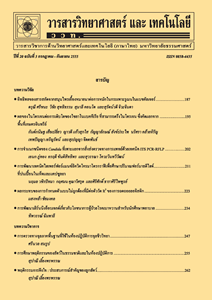ผลของการใช้ Bacillus subtilis สูตรผงและสูตรน้ำในการผลิตผักกาดฮ่องเต้
Main Article Content
Abstract
บทคัดย่อ
สูตรผงคาโอลินและสูตรน้ำกากถั่วเหลืองสำหรับเชื้อปฏิปักษ์ Bacillus subtilis TU-Orga1 ได้พัฒนาขึ้น เพื่อประเมินประสิทธิภาพสำหรับการส่งเสริมการเจริญเติบโตของผักกาดฮ่องเต้และควบคุมโรคขอบใบทองและใบจุดอัลเทอร์นาเรีย ที่เกิดจากแบคทีเรีย Xanthomonas campestris pv. campestris (Xcc) และรา Alternaria sp. ตามลำดับ สูตรผงและสูตรน้ำเชื้อปฏิปักษ์ TU-Orga1 มีประสิทธิภาพในการยับยั้ง Xcc และ Alternaria sp. โดยแสดงบริเวณยับยั้ง 5.0-5.1 มิลลิเมตร และ 80.0-83.3 เปอร์เซ็นต์ ตามลำดับ ซึ่งแตกต่างทางสถิติกับคอปเปอร์ไฮดรอกไซด์ที่แสดงบริเวณยับยั้ง Xcc เท่ากับ 3.5 มิลลิเมตร และแมนโคเซ็บที่แสดงการยับยั้ง Alternaria sp. เท่ากับ 61.1 เปอร์เซ็นต์ การคลุกเมล็ดและพ่นใบด้วยสูตรผงหรือสูตรน้ำเชื้อปฏิปักษ์ TU-Orga1 (>108 cfu/ml) เมื่อผักกาดฮ่องเต้อายุ 29 วัน ส่งผลให้มีการสะสม indole-3-acetic acid (IAA) ภายในลำต้น 11.2-12.3 ไมโครกรัม/มิลลิกรัมน้ำหนักสด และส่งเสริมให้ต้นกล้าอายุ 14 วัน มีความสูงต้น ความยาวราก น้ำหนักสด และน้ำหนักแห้ง 11.8-12.1 เซนติเมตร 3.7-3.8 เซนติเมตร 13.7-14.0 กรัม และ 3.2-3.5 กรัม ตามลำดับ ซึ่งแตกต่างทางสถิติกับการใช้สารเคมี ที่มีความสูงต้น ความยาวราก น้ำหนักสด และน้ำหนักแห้งเท่ากับ 9.1 เซนติเมตร 2.9 เซนติเมตร 8.5 กรัม และ 2.3 กรัม ตามลำดับ ยิ่งไปกว่านั้น สูตรผงและสูตรน้ำเชื้อปฏิปักษ์ TU-Orga1 ยังสามารถชักนำให้เกิดการสะสม salicylic acid (SA) สูงสุด 0.72 และ 0.85 มิลลิกรัม/กรัมน้ำหนักสด ภายใน 1 วัน หลังปลูกเชื้อโรค เพื่อต่อต้านการเข้าทำลายของ Xcc และ Alternaria sp. ตามลำดับ การทดสอบภาคสนามโดยการพ่นใบด้วยสูตรผงหรือสูตรน้ำเชื้อปฏิปักษ์ TU-Orga1 6 ครั้ง ร่วมกับน้ำหมักมูลสุกร พร้อมใส่ปุ๋ยมูลไก่อัดเม็ด 15 กิโลกรัม เพื่อควบคุมโรคที่ระบาดในสภาพธรรมชาติ พบว่าทั้ง 2 สูตร สามารถลดการเข้าทำลายของ Xcc ตลอดจนลดความเสียหายจากด้วงหมัดกระโดดและหนอนใยผักได้ ทำให้ผักกาดฮ่องเต้ผลผลิตสูงทัดเทียมกับกรรมวิธีดั้งเดิมของเกษตรกร
คำสำคัญ : เกษตรอินทรีย์; แบคทีเรียปฏิปักษ์; โรคขอบใบทอง; การควบคุมโรคพืชโดยชีววิธี; การลดต้นทุนการผลิต
Abstract
Kaolin based formula and soybean meal based liquid formula were developed with Bacillus subtilis TU-Orga1, the biocontrol agent and evaluated on enhance growth of pak chai and control black rot and leaf spot caused by Xanthomonas campestris pv. campestris (Xcc) and Alternaria sp., respectively. TU-Orga1 formulas showed significantly inhibitions of Xcc and Alternaria sp. with 5.0-5.1 mm clear zone and 80.0-83.3 %, respectively where copper hydroxide and mancozeb showed 3.5 mm clear zone and 61.1 % of Xcc and Alternaria sp. suppression, respectively. Seed treated and foliar sprayed at 29 day old plants with TU-Orga1 formulas (>108 cfu/ml) increased highest indole-3-acetic acid (IAA) accumulation in pak chai with 11.2-12.3 µg/mg fresh weight and promoted significantly seedling growth (14-day old) with increased shoot height, root length, fresh weight and dry weight by 11.8-12.1 cm, 3.7-3.8 cm, 13.7-14.0 g and 3.2-3.5 g, respectively whereas chemical control showed shoot height, root length, fresh weight and dry weight by 9.1 cm, 2.9 cm, 8.5 g and 2.3 g, respectively. Moreover, TU-Orga1 formulas induced salicylic acid (SA) accumulation within 1 day after challenge inoculation with 0.72 and 0.85 mg/gfresh weight against Xcc and Alternaria sp. infections, respectively. Field experiment with 6-foliar spray intervals of TU-Orga1 mixed with liquid fertilizer swine manure fermentation and added 15 kg of chicken manure fertilizer pellets was conducted against naturally-occurred diseases. The two bio-formulations significantly reduced Xcc pathogen colonization and decreased flea beetle and diamondback moth damaged on pak chai and exhibited the greatest yield compared to conventional treatment.
Keywords: organic farming; antagonistic bacteria; black rot; plant diseases biocontrol; cost reduction


